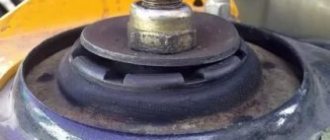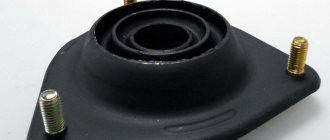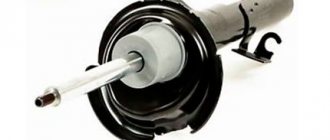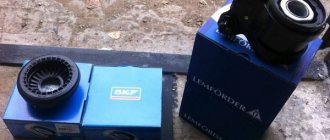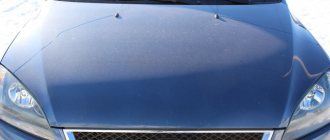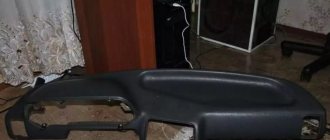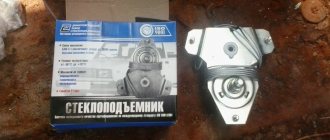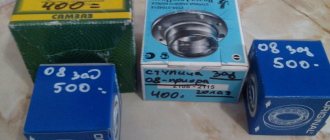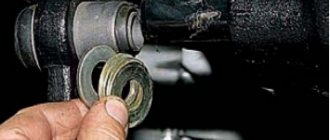Suspension in a car is needed not only to increase comfort while driving, but also to preserve important parts and components that would quickly crumble with constant shaking. The car's suspension absorbs and absorbs all the irregularities on the road. However, in order for shocks to be minimally transmitted to the body, dampers are needed.
For this purpose, the machine is equipped with support bearings. Let's figure out why they are needed, how to determine that they are faulty, and also how to replace them.
Support bearing and front strut support - these concepts must not be confused
Some car owners misinterpret the terms and often buy parts that do not fit or are not needed.
- The support bearing ensures rotation of the rack; it consists of cages with balls.
- The upper support is a housing for the bearing and a transition piece for attaching the strut to the car body.
There must be a certain gap between the car body and the upper cup. A threaded connection is provided in the upper part of the connection with the body; a lock nut is installed on the end of the rod. These parts are marked on the diagram.
Where is the support bearing located, installation location
As already mentioned, the OP is based in the body of the upper support, which is located under the hood of the car, namely on the body cups, under the left and right front wheels.
The upper part of the support is on top of these “glasses”. Usually the stand is fastened with 3-4 bolts, and in the middle of the support there is a central nut securing the rod.
General diagram of the node
Options for the upper support and bearing assembly depend on the car brand. The general connection diagram remains unchanged: the rack is attached to the car body in a strictly defined place. The rigidity of the fastener and the mobility of the unit are ensured by installing a rolling bearing.
Table - detailing of the front pillar assembly
| № | Detail number | the name of detail |
| 1 | 11180-2902840-00 | Bearing |
| 2 | 11180-2902812-00 | Compression stroke buffer with protective cover |
| 3 | 11180-2905002-00 | Telescopic stand right |
| 4 | 11190-2902812-00 | Compression stroke buffer with protective cover |
| 5 | 11190-2905002-00 | Telescopic stand right |
| 6 | 21080-2901056-00 | Nut M14x1.5 |
| 7 | 11180-2902810-00 | Upper strut travel limiter |
| 8 | 11180-2902821-00 | Upper strut support assembly |
| 9 | 21080-2902830-00 | Bolt |
| 10 | 11180-2902834-00 | Upper strut mount compression stroke limiter |
| 11 | 11180-2902760-01 | Upper spring cup |
| 12 | 11180-2902760-00 | Upper spring cup |
| 13 | 11180-2902723-00 | Upper spring insulating gasket |
| 14 | 11190-2902723-00 | Upper spring insulating gasket |
| 15 | 11190-2902712-00 | Front suspension spring |
| 16 | 11180-2902712-00 | Front suspension spring |
Types of support bearings
There are four common design types of journal bearings:
- With integrated inner and outer ring. Has separate mounting holes. Fastening to each other is done using the technological holes available on the body of the part. Accordingly, when installing a spare part in a regular place in the car, there is no need to use clamping flanges.
- With one removable inner ring. Provides maximum rigidity and strength of fasteners, increased resistance to external loads. The design of the product here is made in such a way that the outer ring is rigidly connected to the body. The installation of such spare parts is justified if the most important criterion is the accuracy with which the outer rings rotate while the vehicle is moving.
- With a removable inner ring that allows rotation of the outer ring. This type is the direct opposite of the previous sample. This design is used if there is a requirement for positioning accuracy during rotation.
- A separated outer ring that allows the inner ring of a part to rotate freely. This design is called single-split. Maximum structural rigidity is ensured and service life is increased.
The basis of the above design varieties is a thrust bearing, but some manufacturers complete the support with radial ball bearings without a cage or with a cage or angular contact rolling elements.
Important:
Regardless of the type of product design, the ingress of dirt, high humidity, along with strong impacts, constant high mechanical load, leads to the gradual destruction of the body and its internals.
Problems with the operation of the front upper supports
The maximum service life (operational) of the element is 100 thousand kilometers. During everyday use, this part is constantly subjected to the highest loads.
The most common causes of support bearing failure are:
- mechanical loads;
- aggressive driving;
- hitting potholes;
- metal fatigue;
- corrosion;
- high humidity;
- dust, dirt, tiny particles of sand;
- chemically aggressive environment.
Most often it fails due to mechanical wear, deformation, rust on the surface outside and inside, and lack of lubrication.
Bottom line
It is worth understanding that partial or even complete failure of the support bearing is not a critical failure for the car. However, this does not mean that you can safely drive such a car. In addition, in domestic realities it is better to carry out diagnostics every 10-20 thousand kilometers. It doesn't matter whether there are signs of a malfunction or not. This approach will first of all allow you to save on repairing other elements of the car’s suspension. This applies to shock absorbers, springs, protectors, tie rod ends and the rods themselves. In order to slow down wear, you need to remember to change the oil on time.
You need to maintain your car regularly, otherwise you can become an example of careless and dangerous “care” for your car. And that's not very fun.
Sources used:
- https://zapavto.by/blog-headlines/opornyj-podshipnik-perednej-stojki-chto-eto-takoe-i-dlja-chego-on-nuzhen
- https://avtoexperts.ru/article/oporny-j-podshipnik-perednej-stojki-ustrojstvo-vidy-neispravnosti/
- https://auto-pos.ru/9-priznaki-iznoshennykh-amortizatorov.html
- https://2drive.ru/proverka-opornogo-podshipnika/
The main signs of a malfunctioning front bearings
The following signs indicate a unit failure:
- A clearly audible and clearly felt knock that appears in the area of the front wheel arches every time the steering wheel is turned. Quite often such a knock is transmitted through the steering wheel. In addition to knocking sounds, there are creaks and dull noises when turning.
- Significant deterioration in vehicle controllability, deterioration in the quality of steering.
- Spring breakage.
Of course, knocking may not always be transmitted to the steering wheel. It all depends on the type of car, its brand and design features. But this should not reassure the driver. Failure to take timely measures can lead to complex repairs.
How to spot signs of trouble
If you have to constantly “steer” while driving on a dry, flat road, the part will most likely need to be replaced.
To determine performance, you must perform the following steps:
- Remove the protective caps, then press the upper element of the rod with your hand.
- Rock the car slightly (first longitudinally, then transversely).
- If the test sample is faulty, a characteristic knock will be heard.
Another way:
- Have someone sit behind the wheel and turn the steering wheel from side to side;
- If the suspension element is worn out, you may feel a kickback in your hand, and you will also hear a metallic knock.
Determining the malfunction of the shock absorber and bearings:
Malfunctions
The main sign of a failed support bearing is a knocking sound (dull knocks) in the area of the shock absorber strut. It may indicate that:
- the rubber gasket is damaged or deformed;
- The bearing itself is damaged.
Failure of the support bearing may occur due to:
- resource spent;
- penetration of dirt and moisture;
- exceeding permissible loads;
- mechanical damage due to shock absorber malfunctions.
How to identify a malfunction
To diagnose a support bearing failure, open the hood and remove the “cup” cover. Place your palm on the shock absorber housing and rock the front of the car. If you hear a knock and feel the corresponding vibration with your hand, the bearing is clearly faulty.
When to change
The service life of the “supports” is on average 50-100 thousand km, depending on the conditions in which the car is operated. After this resource has expired, it is recommended to change them. Replacement is also necessary if any malfunctions are detected.
Late diagnosis, as well as ignoring bearing failure, threatens to destroy the shock absorber structure and other suspension elements.
Prices for support bearings for Lada Kalina start from 300 rubles. The shock absorber support assembly costs from 1200 to 3000 rubles. When choosing a support bearing or the entire support, give preference to either the original part or such proven brands as FENOX, TRACK, ASOMI or SS-20.
For the work of replacing one bearing at a service station, you will be asked for an average of 500 rubles. You will have to pay the same amount for adjusting the wheel alignment angle (wheel alignment).
Methods for replacing the front strut support bearing
Advice from auto mechanics - if the suspension parts have not been disassembled for a long time, before dismantling it is recommended to clean the connections from dirt and carefully treat them with a special deep-penetrating lubricant. Prepare the tools in advance: keys, jack, spring tightening device.
It is important to know:
If a leak is discovered during dismantling work, the shock absorber will need to be replaced. A spring that is too weak also needs to be replaced with a working one. All these instances, with high mechanical wear, increase the load on other suspension elements.
Replacement with removal of the rack
The replacement procedure is as follows:
- We hang the car, remove the wheel;
- Unscrew the nut that secures the stabilizer to the strut;
- Disconnect the brake hose;
- Unscrew the steering tip nut;
- Disconnect the caliper and then the brake disc;
- Remove the ball joint mount;
- Unscrew the steering knuckle;
- Unscrew the bolts securing the strut to the car body;
- We dismantle the rack.
- We tighten the springs using ties or a machine.
- Remove the support and take out the bearing.
- We replace the entire support or the ball bearing separately.
- After replacing the worn part, assembly is performed in the reverse order.
Photo report
An example of a repair on a Nissan Qashqai 2:
Removing and installing a new shock absorber:
Replacing the front strut support:
Replacement without removing the stand
Replacing the bearing using this method is also suitable for owners of VAZ (LADA) cars. Removal of the rotary support device is carried out in the following sequence:
- The spring must be tightened with special ties and secured.
- It is important to use special devices to fix the spring in a compressed position. We monitor compliance with safety regulations.
- We hold the rod with a special hex wrench and unscrew the top nut securing the support to the body glass.
- During dismantling work, it is necessary to unscrew the upper bolt to the very end, using a socket.
- We remove the rolling bearing.
- The central spring is dismantled (ties are pre-installed).
- It is necessary to remove the rubber insulator and the lower spring.
- Instead of a worn part, we install a new one in its place.
- If all the anthers and seals remain intact, they can be reinstalled.
Important:
Obviously, the second replacement method is much simpler and less labor intensive. But it is worth noting that this method will not work on all cars.
Photo report
An example of repair on a Lada Kalina car:
Replacing the support without removing the strut:
Quick support replacement:
REPLACEMENT INSTRUCTIONS BY VEHICLE BRAND:
On our website you can see detailed instructions with photos and videos for all types of designs and techniques for the following car models:
- Chevrolet:
- Lanos
- Lacetti
- Cruze
- Aveo
- Focus 2
- Accent
- Lancer 9
- Logan
- A80 B4/B3
- Astra H
- Almera
- Nexia
- Octavia
- Corolla
- Ceed
Note:
If your car is not on the list, choose by brand, in 90% of cases the instructions will be suitable for you!
Consequences of late repairs
A worn shock absorber mount will reduce the service life of shock absorbers, springs, connecting rods and steering rods. The operation of the ABS system is disrupted, the wheel alignment angle is lost and, as a result, the steering wheel wobbles and uneven wear of the tire tread appears.
It is worth noting that replacing the front shock absorber supports must be done in pairs. This opinion is shared by the overwhelming majority of service stations. If it's time to change the right support, then the left one too, even if it is still serviceable. Otherwise, body roll may occur when turning, and the car will begin to pull to the side.
This is interesting: Why do you need to tow a car?
When replacing shock absorbers, it is also recommended to replace the supports.
Important features of installing the front shock absorber strut mount
- If the suspension has not been disassembled for a long time, 1 day before repair you should clean all components and connections from dust and dirt. Next, carefully treat with a special deep-use lubricant (this will make it easier to unscrew the connected parts);
- be sure to use a special spring tie;
- special attention must be paid to the accuracy of the position of the spring when installing it;
- the end of the coil is attached to reinforced places on the lower plate and shock absorber rod;
- install the beginning of the spring coil in the deepest part of the insulator;
- before installing the shock absorber in place, it is necessary to “bleed” it by making 5-6 movements;
- before installation it is necessary to lubricate the part;
- when installing the rack in its original place after replacing the front element, you will need to use a torque wrench; all tightening of threaded connections must be made with the most accurate force.
Shock absorber knock and support support replacement:
Useful tips for use and purchase
Lubrication procedure
A rolling bearing can be lubricated by one of four types of lubricants: solid pastes, plastics, liquids and gases. High-quality lubrication will reduce friction, reducing wear of parts.
If you use silicone spray, all that is necessary is to cut the substance into the body area, trying to treat all the most inaccessible places. But the best way is to treat the part with lubricant at the time of installation in its original place (as well as each time the device is dismantled).
How to extend the life of the front strut support bearing
- Compliance with the speed limit, driving on smooth roads without holes, potholes, etc. increases resource and service life. Aggressive style leads to increased loads on the racks, resulting in failure.
- It is also important to regularly check the unit according to the instructions in this article.
- When making repairs, purchase only original spare parts.
- Monitor the tightness of the assembly under the hood.
Rules for choosing a bearing taking into account the manufacturer
When purchasing, pay attention to the following companies:
- Lemforder
- SKF
- RUVILLE
- Febest
- F.A.G.
- SNR
- VBF (for VAZ)
Contents of delivery
The scope of delivery depends on the specific part purchased. If it is a bearing, then the kit does not include additional equipment. If it is a support, the kit usually includes mounting bolts and washers, and the bearing itself. Check the equipment on the manufacturer's website or before purchasing.
Important tips for replacement and operation
Tip 1
Should I change one prop or both? Pair replacement is performed as reinsurance. This method is acceptable for a new car that is under warranty. In other cases, replacement of a worn-out spare part is carried out upon detection of a malfunction.
Tip 2
Is it necessary to do a wheel alignment? If, when disassembling parts, levers, struts, and other suspension elements were dismantled, checking the installation of angular indicators is necessary. If the replacement, for example, on a VAZ car was carried out without dismantling the strut, then a wheel alignment is not required.
Tip 3
Before performing work, prepare new spare parts and special tools: spring pullers, torque wrench, set of sockets. Before starting repairs, you need to buy spare parts. If you have any doubts about self-repair, contact a car service center.
Signs of shock absorber wear
There are several warning signs that can help you determine when your shock absorbers need replacing. For example: your car, after driving over railroad tracks, speed bumps, or dips in the road, continues to bounce after the fact.
Other signs include unusual noises over bumps, excessive body roll when cornering or when braking, where the front of the car dives forward sharply. Since shock absorbers wear out gradually, you can easily get used to such driving, just as you get used to a longer braking distance when the brake pads wear out.
How to determine shock absorber wear?
One way to check your shock absorbers is to press hard on each corner of your car. And if the car continues to bounce after you let go, then it's time to replace the shock absorbers. However, this test can be quite labor intensive and many SUVs or pickup trucks will not be able to test the shock absorbers this way.
Instead, you should have your shock absorbers inspected on a lift by a qualified mechanic. The mechanic will be able to see if there are any serious leaks (shock absorbers filled with fluid), if the mounts or bushings are worn, and if there is physical damage such as dents.
Despite the recommendation that shock absorbers should be replaced at certain intervals (most often we hear this from auto parts sellers), for example, every 80,000 kilometers. However, the need for replacement may vary depending on the vehicle, road section and vehicle load.
If you frequently drive on rough, uneven roads that put extra stress on your shock absorbers, you'll likely need to replace them more often than if you drive on a smooth freeway. Also, when transporting heavy loads, shock absorbers wear out faster.
